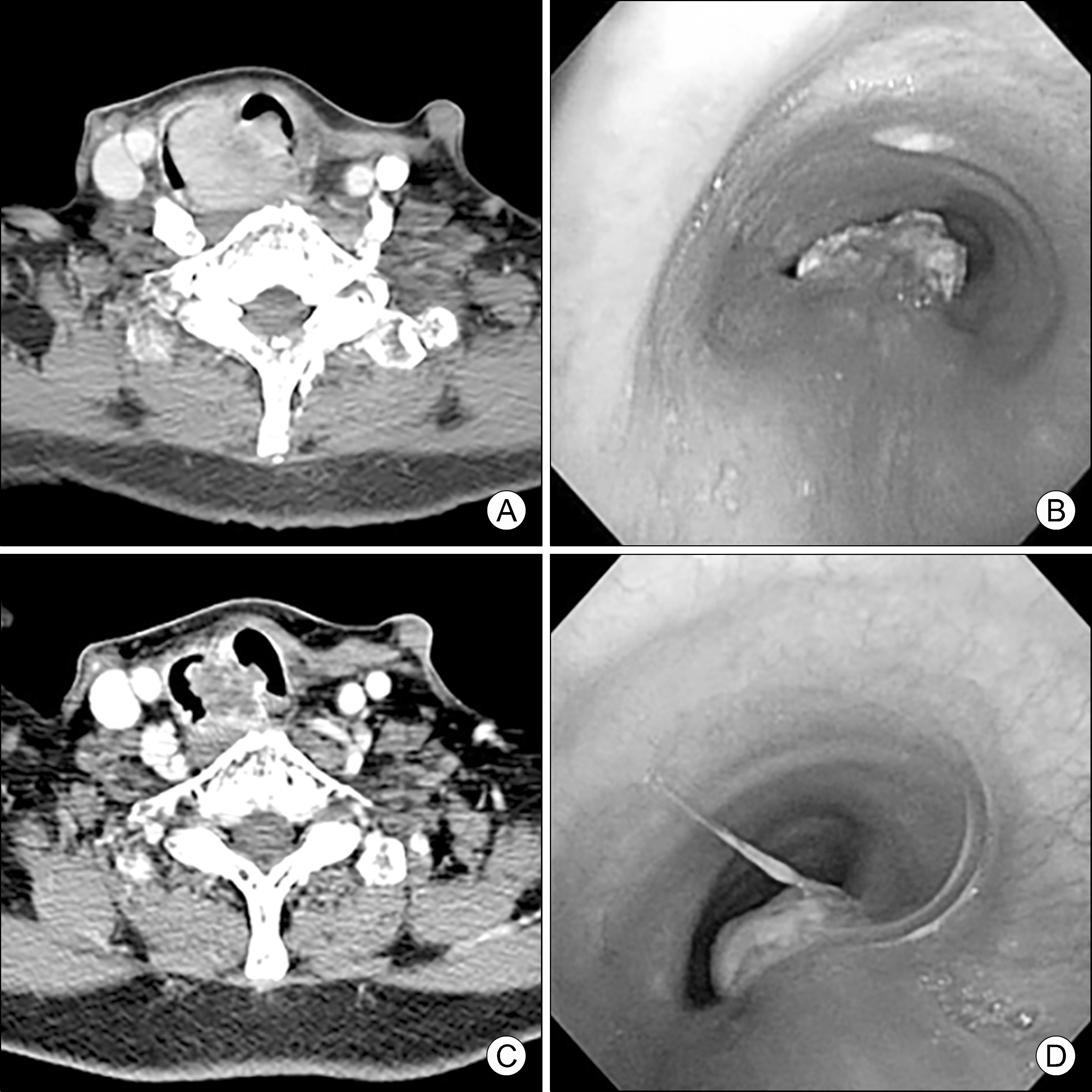Int J Thyroidol.
2016 Nov;9(2):210-214. 10.11106/ijt.2016.9.2.210.
Development of Tracheoesophageal Fistula after the Use of Sorafenib in Locally Advanced Papillary Thyroid Carcinoma: a Case Report
- Affiliations
-
- 1Department of Internal Medicine, Asan Medical Center, University of Ulsan College of Medicine, Seoul, Korea. wongukim@amc.seoul.kr
- KMID: 2362361
- DOI: http://doi.org/10.11106/ijt.2016.9.2.210
Abstract
- Sorafenib, an oral multi-kinase inhibitor, is used for the treatment of patients with radioactive iodine (RAI) refractory differentiated thyroid carcinoma (DTC) with favorable outcomes. Some unusual but fatal adverse effects are known for this drug and tracheoesophageal fistula (TEF) is one of them, which has never been reported in thyroid cancer patients. We present a successfully treated patient who had developed TEF associated with rapid tumor regression during sorafenib treatment for locally advanced papillary thyroid carcinoma (PTC). Sorafenib was discontinued and feeding jejunostomy tube was placed for nutritional support. 3 months later, the TEF had successfully healed and there was no visible fistula track or interval change of the viable tumor during 15 months of follow-up. Identifying patients at high risk for this potential complication and paying special attention when prescribing anti-angiogenics to these patients are crucial to prevent associated morbidity and mortality.
MeSH Terms
Figure
Reference
-
References
1. Hundahl SA, Fleming ID, Fremgen AM, Menck HR. A National Cancer Data Base report on 53,856 cases of thyroid carcinoma treated in the U.S., 1985–1995 [see comments]. Cancer. 1998; 83(12):2638–48.2. Mazzaferri EL, Jhiang SM. Long-term impact of initial surgical and medical therapy on papillary and follicular thyroid cancer. Am J Med. 1994; 97(5):418–28.
Article3. Durante C, Haddy N, Baudin E, Leboulleux S, Hartl D, Travagli JP, et al. Long-term outcome of 444 patients with distant metastases from papillary and follicular thyroid carcinoma: benefits and limits of radioiodine therapy. J Clin Endocrinol Metab. 2006; 91(8):2892–9.
Article4. Brose MS, Nutting CM, Jarzab B, Elisei R, Siena S, Bastholt L, et al. Sorafenib in radioactive iodine-refractory, locally advanced or metastatic differentiated thyroid cancer: a randomised, double-blind, phase 3 trial. Lancet. 2014; 384(9940):319–28.
Article5. Schutz FA, Je Y, Richards CJ, Choueiri TK. Meta-analysis of randomized controlled trials for the incidence and risk of treatment-related mortality in patients with cancer treated with vascular endothelial growth factor tyrosine kinase inhibitors. J Clin Oncol. 2012; 30(8):871–7.
Article6. Rodriguez AN, Diaz-Jimenez JP. Malignant respiratory-digestive fistulas. Curr Opin Pulm Med. 2010; 16(4):329–33.
Article7. Gschossmann JM, Bonner JA, Foote RL, Shaw EG, Martenson JA Jr, Su J. Malignant tracheoesophageal fistula in patients with esophageal cancer. Cancer. 1993; 72(5):1513–21.
Article8. Spigel DR, Hainsworth JD, Yardley DA, Raefsky E, Patton J, Peacock N, et al. Tracheoesophageal fistula formation in patients with lung cancer treated with chemoradiation and bevacizumab. J Clin Oncol. 2010; 28(1):43–8.
Article9. Goodgame B, Veeramachaneni N, Patterson A, Govindan R. Tracheoesophageal fistula with bevacizumab after mediastinal radiation. J Thorac Oncol. 2008; 3(9):1080–1.
Article10. Gore E, Currey A, Choong N. Tracheoesophageal fistula associated with bevacizumab 21 months after completion of radiation therapy. J Thorac Oncol. 2009; 4(12):1590–1.
Article11. Regalbuto C, Frasca F, Pellegriti G, Malandrino P, Marturano I, Di Carlo I, et al. Update on thyroid cancer treatment. Future Oncol. 2012; 8(10):1331–48.
Article12. Shen CT, Qiu ZL, Luo QY. Sorafenib in the treatment of radioiodine-refractory differentiated thyroid cancer: a metaanalysis. Endocr Relat Cancer. 2014; 21(2):253–61.
Article13. Blevins DP, Dadu R, Hu M, Baik C, Balachandran D, Ross W, et al. Aerodigestive fistula formation as a rare side effect of antiangiogenic tyrosine kinase inhibitor therapy for thyroid cancer. Thyroid. 2014; 24(5):918–22.
Article14. Hu Y, Zhao YF, Chen LQ, Zhu ZJ, Liu LX, Wang Y, et al. Comparative study of different treatments for malignant tracheoesophageal/bronchoesophageal fistulae. Dis Esophagus. 2009; 22(6):526–31.
Article
- Full Text Links
- Actions
-
Cited
- CITED
-
- Close
- Share
- Similar articles
-
- Concurrent Medullay and Papillary Carcinoma of the Thyroid
- A Case of the Esophageal Atresia with Distal Tracheoesophageal Fistula Associated with Duodenal Obstrction
- Tracheoesophageal Fistula Following Prolonged Tracheostomy Cannulation
- Four Cases of Malignant Pleural Effusion in Patients with Papillary Thyroid Carcinoma
- A Case of Locally Invasive Thyroid Papillary Cancer Diagnosed by Esophagoscopy



